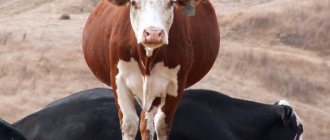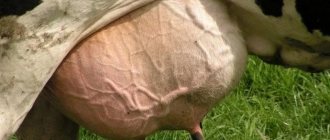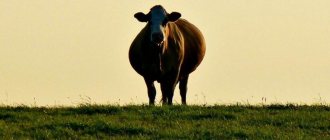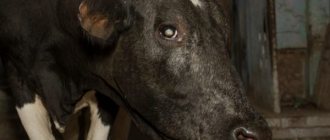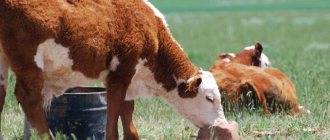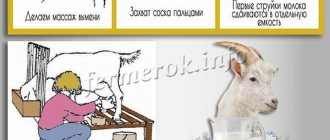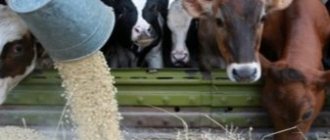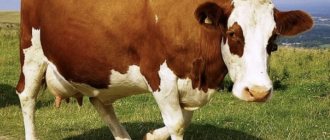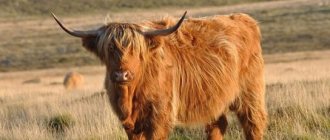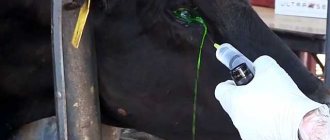Cow after calving
Calving is a tiring process for any animal. In addition, it lasts for different amounts of time. The most important thing that a cow needs during this period is proper rest. The presence of clean, warm water (approximately +25 degrees) is required in the quantity determined by the animal itself. The cow must have constant access to water. If the cow still does not get up after giving birth, she needs to be watered from some low container. You should not give cold water to a calving female: the body, weakened by pregnancy and calving, is susceptible to various kinds of diseases.
A little later, you can offer the cow hay; hay made from legumes and cereals is suitable for this. While the cow is resting, you need to quietly monitor her in order to prevent any postpartum pathologies in time. After the cow has had a good rest and is back on her feet, milking can begin.
How to accustom a first-calf to milking?
A young cow may be afraid of the milk production procedure, so the owner should be especially attentive to her. How to milk a cow after her first calving? 2-3 months before giving birth, the owner can accustom the animal to stroking the belly and udder. In this case, the cow most often takes milking calmly.
If the first heifer kicks, the owner may tangle her hind legs. There is another way to pacify an obstinate animal, which is often used in villages. The front leg is tied up and raised up. The heifer, balancing on 3 limbs, will not be able to kick, and the owner will calmly milk her. Sometimes it is enough to threaten a cow with a twig, and after that she will stand still.
First milking
After calving, it is necessary to carry out basic hygiene procedures. To do this, wipe the back of the animal's body with a stiff brush. This manipulation is not only hygienic in nature. These actions promote contraction of the uterus due to the outflow of blood from it. The udder and external genitalia should be washed with warm water and a disinfectant added. Furacilin or potassium permanganate are suitable for this. In order to help the animal quickly restore water-salt metabolism in the body, it is given amniotic fluid in an amount of about 5 liters.
If it was not possible to avoid mastitis, and after calving its signs appeared (swelling and hardness of the udder), then the first milking should occur immediately after calving. In this case, it is necessary to achieve complete expression of milk from the udder. A calf should not be allowed near a cow that has developed mastitis.
When to start milking a cow after calving
As a general rule, a cow should be milked one and a half to two hours after calving. However, before this, it is very important to restore the water and electrolyte balance in the animal’s body, as well as to prevent possible postpartum infections, since compliance with this condition largely determines how much milk the heifer will produce in the future.
To do this, before the first milking begins, very simple but necessary emergency measures should be taken:
- Intensively rub the back of the animal's body with a stiff massage brush (you can use a homemade product at hand, rolling dry hay or straw into a tight ball). This procedure will speed up the contraction of the uterus, ensuring the outflow of blood from it.
- Carefully rinse the udder, vulva and surrounding skin with a disinfectant (you can use furatsilin or a weak solution of potassium permanganate) and wipe dry with a soft cloth.
- Give the animal one and a half buckets of water, heated to the temperature of the human body, in which 150-200 g of ordinary table salt must first be diluted (according to another technology, instead of salt, sugar is added to the water at the rate of 0.5 kg per 10 liters).
Important! Amniotic fluid is the best way to restore water-salt metabolism and replenish the body with essential minerals. During calving, they should be collected and the animal should be allowed to drink at least five liters.
The cow is then fed a small amount of fresh, high-quality hay, and, if desired, a liquid mixture of oats and bran or a swill of steamed oat flakes. An hour after the animal has eaten, it can be milked. The described rules apply to a situation where the birth went well and the cow feels well.
If an animal has developed mastitis (the udder is swollen and hardened, this process usually manifests itself even before calving), the cow should be milked immediately after the end of labor, and you should try to free the udder completely.
The resulting colostrum is destroyed and cannot be given to the calf to avoid infection or medications that were used to treat the mother entering the baby’s body (both bacteria that cause mastitis and antibiotics get into the milk and can cause serious disorders and even death of the calf).
Important! At least two months before the expected calving, milking of the cow stops. This is necessary in order to allow the animal’s body to gather strength for full and abundant lactation, however, in addition, stimulation of the udder can provoke premature birth. The exception to this rule is mastitis. When its symptoms appear, the animal must be milked both before calving and immediately after it.
For the same reason, a baby is not allowed to milk a cow with mastitis, although it is the calf that is able to develop a swollen udder as safely and intensively as possible. An even more severe complication after childbirth is paresis or, as it is also called, coma of dairy cows.
Paresis in a cow This disease is of a nervous nature and is manifested by severe tremors in the limbs, staggering and even paralysis, accompanied by fainting. If a fresh cow shows such signs or lies with its neck arched in a characteristic manner, it needs emergency help.
For this purpose, as a rule, a special technology is used to pump air into the udder, resulting in the “correct” impulse entering the brain. If the procedure helped and the animal is firmly on its feet, milking begins after two hours. Otherwise, treatment is continued.
Razdoy
Milk yield is usually understood as a set of special measures aimed at obtaining the highest possible daily milk yield. This complex includes the development of an optimal feeding diet, proper maintenance and milking, and udder massage.
The first milking occurs 1.5-3 hours after calving. The udder is washed with warm water at a comfortable temperature. This procedure must be followed before each milking.
You need to handle first-calf heifers carefully: all movements must be calm and careful so that the animal gets used to the hands of others. Otherwise, it will behave restlessly, kick and try to move to the side. After there is almost no milk left (a little should be left in the udder), the nipples are lubricated with a softening cream. This must be done to avoid the appearance of cracks and wounds on them.
About 2 weeks after calving, experienced farmers begin so-called advance feeding. This term means that the volume of feed is gradually increased. To milk a cow normally, you need to do several approaches per day. The recommended amount is five times a day.
If positive dynamics are present, then it is necessary to continue feeding according to the same scheme. If suddenly there is no increase in milk yield, then you need to give the animal milk feed.
Important! Turnips, beets, yeast, egg whites and high-quality hay help increase lactation.
Organization and technique of milking cows
This process, in accordance with the technology, includes the following activities (Figure 4):
- Timely start of pregnancy and compliance with a special feeding regime during the dry period. Juicy foods are excluded from the diet and replaced with high-quality hay and other foods that do not stimulate milk production. In addition, milking is gradually stopped in preparation for calving.
- Advance feeding after calving. To do this, it is necessary to gradually increase the amount of feed in the diet so that the daily volume of feed is one and a half to two times higher than the usual norm.
- Regular milking and udder massage . After calving, the udder often becomes swollen or hard. To do this, you need to increase the number of milkings to 5-6 per day. At the same time, an udder massage is performed, which not only relieves swelling, but also promotes more intense milk production.
Figure 4. Organization of milking according to physiological periods.
Cows begin to milk milk not immediately after calving, but after a few days, when she stops producing colostrum.
First milking
As soon as the cow has calved, she needs the first 1.5 hours to rest. After this time, you can begin your first milking. It is not recommended to milk all the milk during the first milking; postpartum paresis may occur. Therefore, a small amount of milk is left in the udder.
For about a week after the birth of a calf, it is not recommended to begin any activities that will increase milk yield and stimulate lactation. During this period, colostrum is released - a product that will be fed to the calf. After normal milk flows, you can begin to increase milk production. This period is necessary for the cow to get a little stronger and recover after calving.
In any case, even after the release of colostrum is completed, all manipulations are carried out gradually. In this case, you need to massage the udder and introduce succulent feed. Massage is effective, you should not forget about it even when milk yield is reduced for some reason.
How is a cow milked?
How to milk a cow correctly? If there is only one individual on the farm, then it is better to milk it by hand. In this case, purchasing a milking machine is not advisable.
The most important factor in the process of hand milking is the ability to grasp the nipple correctly. To do this, place all your fingers on the nipple so that the thumb covers the index finger, being on top, and the little finger should be located on the outer part of the nipple. When clenching your fist, make sure that the nipple does not curve and that the milk flows without touching your hand.
The fingers should be squeezed gradually: starting from the top and ending with the little finger.
When squeezing the little finger, make sure that the top fingers are also squeezed so that the milk does not flow back into the udder. After this, immediately unclench your fist without removing your fingers from the nipple. Repeat the manipulations.
During milking, milk should flow in a constant, continuous stream.
The rear parts of the udder are milked first, then the front parts. Finally, the rear ones again. The colostrum obtained during milking can and should be given to the calf to drink. Please note that his next feeding should occur in 6 hours.
After milking, the cow's udder needs massage again. This is especially true for first-calved individuals or animals with tight udders. A good massage promotes complete milking, and this, in turn, leads to an increase in its volume. Do not forget that the last milk milked has the highest percentage of fat content. How does cows milk with a milking machine? Before you start milking with a machine, you should, in the same way as with the manual method, prepare the cow's udder by first massaging it. Be sure to wash your hands and udders using a laundry soap solution. Dry the udder with a clean towel. Disinfect the device itself.
Then put the suction cups of the device on the nipples so that as little air gets in as possible. Choose a regimen that suits your animal.
On average, this is 7 minutes with a pulsation frequency of 40 to 60 beats per minute.
Feeding
It is important to remember that during the period of milking the cow, all concentrated feeds are subjected to yeast before feeding. This term should be understood as the process of fermentation of grain feed with yeast starter. This biological method increases the nutritional value of feed and taste.
Yeasting has the following advantages:
- The fermentation that occurs during yeast promotes the formation of probiotics - beneficial bacteria. They have a positive effect on the animal's gastrointestinal tract.
- Fermentation makes heavy grain feeds easily digestible.
- Eating animal feed that has undergone fermentation helps strengthen the immune system.
- Fermentation increases the amount of protein in feed. This helps animals survive even the harshest winter.
- With the help of fermentation, vitamins B, C and K are released into the feed and the body absorbs them easily and quickly.
- Fermented food makes you thirsty. The animal consumes more fluid, which has a positive effect on lactation.
- At the same time, some savings are observed. Fermented feed becomes the most nutritious, therefore, the animal is able to eat less of it at one time. That is, there is a double benefit: less feed is absorbed, but there is more benefit and yield from it.
- Cows willingly eat feed that has undergone yeasting, and their appetite improves.
How and what to feed
After calving, hay is given to the cow ad libitum.
The cow should be fed with hay or fresh grass, and given mash with light concentrates. After 2 days, they begin to add succulent feed, but the amount of concentrates in the diet should not be reduced.
Important! You should not overfeed the cow from the first days: she cannot finish the food, her appetite decreases, intestinal activity is disrupted, and inflammation of the udder is possible. Yield is rapidly decreasing.
If everything is in order, the cow is healthy, the udder is in normal condition, then on days 8-12 you can give a full ration of feed. There is another way of feeding: in the first days only hay is given, and after a week a full diet is introduced.
[adsp-pro-4]
The amount of feed depends on the following factors:
- weight and fatness of the animal;
- amount of fat in milk;
- month of calving (in winter the diet will be different);
- amount of milk.
The higher the milk yield and fat content of milk, the richer the diet should be, with more nutrients: proteins, carbohydrates, fats, vitamins. After the first and second calving, the diet is gradually increased for the further growth of the young heifer. An increased diet is also recommended for malnourished cows.
The more milk a cow produces, the more feed she is given.
With proper care and distribution, the amount of milk after calving gradually increases, reaching a peak at the end of the first month; maximum milk yield persists throughout the second month, sometimes even the third. Then the milk yield begins to decrease.
Method of milking
To quickly milk a cow, a number of conditions must be met:
- It is necessary to stop milking the pregnant female in time (start it). During the same period, a diet is introduced that is used for animals during dry periods. That is, they stop giving the cow succulent feed. Instead, she is transferred to those products that will not provoke lactation. Milking is stopped gradually, this helps prepare for the next lactation.
- Advance feeding, as already mentioned, is practiced after colostrum production stops - about a week after calving. Gradually, the daily volume of feed consumed will exceed the usual daily dosage by 1.5-2 times.
- Milking should be regular, preceded by udder massage. With the help of massage, it will be possible to eliminate the stiffness of the udder after calving; the same manipulations will prevent the formation of udder edema. If you milk the animal 5-6 times a day at first, you can alleviate its condition. The normal number of milkings is 3 times a day. The animal is gradually transferred to this regime. If spontaneous leakage of milk occurs between milkings, it means that three milkings are not enough for the animal; it needs to be milked 4 times. If milk is released from the udder on its own, this will lead to inflammation of the udder.
The process of milking a cow
Immediately after calving
Calving is the process during which the gestation and birth of a calf occurs. At this time, the heifer spends a lot of energy on giving birth to young animals, but she cannot stop milking.
How to milk a cow after calving? After the female has given birth, you must wait 15 days. This is necessary because at this time she secretes substances that go to feed the calf. After this period, milk can be consumed for human consumption.
Don't try to get maximum volume. This will lead to overstrain of the mammary gland, and all sorts of diseases may occur. To milk a heifer after giving birth you must:
- give salt water to the cow half an hour after giving birth, this will remove thirst and help restore strength;
- After 2-3 hours you can start milking, but you must not overdo it - milking all the milk is prohibited, otherwise this will lead to illness in the animal. This milk must be given to the calf.
Milking must be done 3 to 5 times a day to avoid stagnation. After each milking, massage should be done.
Cow udder massage
After a false pregnancy
There are cases when cows experience a false pregnancy. It is very difficult to distinguish it from the usual one, only with a special examination by a veterinarian. During a false pregnancy, the belly also swells, but subsequently fluid comes out instead of the calf. There is nothing wrong with this, just a normal biological process.
After all the liquid has come out, you need to carefully start dispensing. It is advisable to wait a few hours. It needs to be started carefully, gradually milking out the milk product, but not all of it.
How do the nutritional value of the diet change when cows are milked?
Food is the main source of energy for any organism. Therefore, it is worth paying attention to your diet.
It's no secret that food directly affects the quantity and quality of milk. If you want to increase your milk yield, you need to include in your diet:
- roots;
- special feed;
- increase the amount of grass and hay.
It is necessary to introduce fruits and vegetables into the diet to maintain vitamins and other beneficial elements. Without them, the amount of dairy product will not increase. Don’t forget about special additives that increase milk yield.
Proper nutrition improves milk yield
You also need to take into account the desired volume of milk, and from this choose a suitable diet, and in addition to everything, take into account the characteristics of your cow:
- average. With such a cow, you can count on increasing the amount of milk by 3-4 liters;
- highly productive. If you have such a cow, then you can increase your milk yield by 4-6 liters;
- unproductive. It is very difficult to increase the volume of milk produced with the help of a certain diet; it is better to use special supplements.
Attention! Under no circumstances should you feed a cow the same type of food, this will only reduce the amount of milk.
If the animal has not increased its milk yield, then an experiment should be conducted: give certain products for about a week and observe what causes the amount of product to increase. The diet needs to be changed every 2-3 weeks. You cannot overfeed the animal, this leads to loss of appetite and even milk. Instead of eating a lot of food, you need to water the cow well.
Milking
There are times when a small amount of milk is milked due to improper milking technique. Therefore, you must follow all the milking rules:
- Schedule. The heifer needs to know when milking will begin. This will help her produce as much milk as possible at this time.
- Feeding. The animal must be fed two hours before milking with food that increases milk yield.
- Before the process, you need to wash and wipe the udder. The first small amount of milk should not be poured into a common container - they contain germs and pathogenic bacteria. When draining, you need to pay attention to the liquid: there should be no blood clots or mucus in it, because this is a sure sign of an animal’s illness.
Manual milking
During the process, you need to milk the back and then the front udder, but not with your fingers, but with your whole fist. If you milk incorrectly, you can injure the udder or introduce dirt; you should not allow milk to flow through your fingers. The entire milking should be done in no more than 5 minutes. If there is still milk left, then you cannot touch it. Subsequently, you can learn to milk most of the milk during this time. But this will take some time. Proper milking increases the amount of milk product. Milking a cow after calving must be done in the same way, only with even greater care.
Some farmers use two-phase milking after calving instead of three-phase milking, which is considered more profitable. The cow needs to be milked twice a day instead of 3-4. Two-phase milking will save time, but it is still best to milk the animal frequently. If the milk is not removed in time, it will disappear, and this is dangerous for the animal itself.
Massage
To maximize your milk supply, you need to massage your udder regularly. This helps soften the skin and increases milk output, preventing the occurrence of any diseases. The correct process includes:
- First you need to wash the udder. After carefully examining for spots, rashes, this is necessary to identify diseases in time.
- You need to massage from bottom to top, from the sides to the center.
- Be sure to lift and lower the udder during the process.
- When massaging, you need to pay attention to both the entire udder as a whole and individual parts.
The massage procedure should be performed every day, or several times a day - this will promote greater milk production. The use of additional special softening ointments is encouraged. If you do everything correctly, then after a while the amount of milk will increase significantly.
Udder massage
Preparation for milking
Preparation for milking begins long before the calf is born. It is necessary to prepare from the moment the heifers are raised for offspring. In order to quickly and effectively milk an animal after calving, the following conditions must be met:
- Properly prepare cows and first-calf heifers for birth.
- Provide good conditions for calving.
- Prepare the correct diet for calving cows and gradually introduce a full diet.
- Monitor daily milk production.
- Gradually change the number of feedings and milkings.
- Introduce foods with milk-producing properties into your diet.
- Adhere to the most effective milking techniques and use massage. It is believed that massage can begin in heifers, at about 6-8 months of pregnancy. A short massage of 3-7 minutes is enough for the mammary glands to develop properly. In addition, massage can increase milk yield by about 15-20%. Many argue that with the help of massage you can prepare cows for machine milking. The massage is carried out manually or using special pneumatic massage units. But about 2-3 weeks before calving, all detailed activities stop.
- Maintain a daily routine in the barn with dairy cows during feeding and milking.
- Provide pregnant animals with daily walks in the air.
All of the above procedures contribute to the formation of conditions in which excellent milk yields can be obtained.
Heifer nutrition
A cow's milk production depends on the balance of her diet. If the first heifer is kept on hay and water after giving birth, then it is pointless to expect high milk yields from her. After the baby is born, the cow should eat a lot of high-quality bulky food. The basis of her diet for this period is good hay. But the first heifer should also receive grain.
Immediately after giving birth, the cow develops udder swelling. It is in the owner's interests to get rid of it as quickly as possible. Therefore, until the swelling disappears, you cannot increase the grain rate; this will only intensify it. After the first heifer's udder returns to normal, either salt or mineral lick is introduced into her diet. The grain supply rate begins to increase from 2-3 weeks after birth. All changes in the cow's diet should be gradual.
Milking at different times
Cows that already have a milk production of about 3000 kg can increase it even further (by about 850-1000 kg). To do this, you need to follow the advice on milk production during different periods of lactation.
First period
This is approximately 100 days after calving. This period is characterized by the highest milk yields, which can amount to 60-70% of the total annual productivity.
When a cow has calved without pathologies, the animal can be given any amount of feed almost immediately. The only important thing is that they are juicy. Their number is added gradually.
Already 8-10 days after calving, the animal should receive the full amount of feed. Immediately after the calf is born, good udder care is important. This will help avoid mastitis and swelling. If the cow is one of the highly productive individuals, then one should expect milk yields that exceed previous indicators.
Second period
This is approximately 102-305 days. Here it is important to correctly calculate the amount of concentrated feed in the diet. Their norm is determined depending on milk yield indicators.
Third period
This is all the rest of the time after day 305. It is recommended to feed a large amount of bulk feed plus some concentrates (in a ratio of approximately 93:7). All changes must be gradual. When a cow is 5 months pregnant, her milk yield drops. This result will last for another 8-10 weeks until the period called dry wood. Here, the most important attention should be paid to the growth and development of the fetus - the diet is formed based on this.
It is important to help the cow accumulate nutrients, so she should be reasonably fat by the time she is brought in. The intrauterine development of the calf, future milk production and many other indicators depend on how correctly the launch is carried out. In order not to harm the animal, the launch is carried out as follows:
- Approximately 2 weeks before the complete cessation of milking, animals must be switched to a low-energy diet. This will help reduce milk production naturally.
- It is recommended to start skipping one milking per day; it is necessary to knock the animal off the usual milking schedule.
- In summer, reduce the number of hours you spend grazing.
Is it possible to let a calf in?
In villages, the method of keeping young animals under a cow is common. After birth, the calf is left with its mother, and the owner milks the cow a little several times a day. This method has a right to exist, but it is more suitable for meat breeds of animals. In a dairy cow, the calf will spoil the udder. In addition, she will begin to squeeze milk for her child, so the owner may not get anything.
It is especially harmful to keep a baby under a first-calf heifer. It will be difficult to accustom such cows to milking. A cow can kick, kick her owners, and overturn a milk bucket. Then people will try to get rid of the obstinate cattle or hand them over to a meat processing plant. How to milk a first heifer correctly? The baby that is born must be taken away immediately; soon the cow will forget about him. Afterwards, the owners must empty the first-calf's udder themselves, following the basic rules of milking.
Factors preventing normal milk production
If all the rules are strictly followed, not every cow is able to respond to this by increasing milk yield. There are several reasons for this:
- Genetic predisposition. There are individuals who, due to their heredity, are unable to produce normal volumes of milk.
- Diseases that have a detrimental effect on the overall well-being of the animal, including its milk yield. This effect is exerted by diseases caused by parasites and various types of inflammation.
- Lack of body weight of a cow before milking begins.
- Starting too late, improper feeding in dry wood. This leads to severe exhaustion of the animal and weakening of its body.
- Constant presence of cows in cramped, unventilated rooms, lack of walking and physical activity.
What is distribution
By milking a cow we mean a whole range of measures for keeping, feeding and milking. Its goal is to obtain maximum milk yield throughout the entire lactation period. Proper milking of a cow consists of:
- Advance feeding,
- Regular udder massage,
- Proper first milking,
- Daytime organization.
The entire lactation period consists of four stages:
- During the first seven days, colostrum is released, which is only suitable for feeding the calf,
- The second stage is distribution,
- The third stage is lactation,
- The fourth stage is old milk, which is not suitable for drinking.
Colostrum contains a lot of protein, immune bodies and various enzymes, and is intended for feeding calves.
The cow's milk, which is usual for humans, appears only seven to ten days after the cessation of colostrum secretion.
Expert advice
Here is what is recommended to do to increase milk yield:
- The first days after calving, the udder of cows is very tense, so milking within 3 days after birth should be as careful as possible.
- Compliance with the feeding regime helps preserve milk yield during the milking period. Any interruptions in the feeding schedule contribute to problems with the cow’s digestive system, and the animal becomes too nervous.
- It is equally important to milk the cow at the same time. If you do this chaotically, you can lose milk yield completely.
- Often after calving, cows develop udder diseases (most often - mastitis, less often - bloody or even purulent discharge, swelling). In this case, the animal must be examined by a veterinarian, diagnosed and prescribed treatment. Most likely, you will have to stop using milk during the treatment period. It should not be given to a calf or used as food.
- It is necessary to closely monitor the general well-being of the cow after calving and during milking. If you suspect any disease, you should contact a veterinarian.
- After calving, the cow should not overeat. At the same time, all feed should be as nutritious as possible. It is better to feed the animal more often, but in small portions.
- It is advisable to avoid feeding dry concentrates. The best way out is to cook mash with them. This way the cow will simultaneously receive nutritious feed and some portion of liquid, which she needs to stimulate lactation. It is also recommended to add concentrates in mixtures with root crops or juicy silage.
- If a cow produces milk with high fat content, she needs to be fed more food.
Main activities for milking first-calf heifers
Milking in some ways can be compared to harvesting. You can grow a record amount of cereals, for example, but miss the harvest time. It’s the same in cattle breeding: you can acquire high-yielding cows, but due to illiteracy you cannot get the maximum possible amount of milk from them. That is why such great importance is given to distribution. Razdoy increases milk productivity from 20 to 28%. Despite the fact that at the end of this event the amount of milk is significantly reduced, the highest daily indicator will exceed the initial one by 30-40%.
Milking should begin 7 - 10 days after the first calving
Actions aimed at milking cows include:
- advance feeding;
- competent milking and udder massage;
- compliance with basic maintenance rules and sanitary and hygienic standards;
- correct daily routine.
When caring for a female, it is very important to adhere to a certain regimen. There should be equal time intervals between meals, just as milking should be done at the same time. When the cow’s body gets used to the proposed schedule, it will function like a clock and have time to produce the required amount of milk.
Milking occurs in the first 100 days of lactation, which are the highest yielding days.
Running cows
Timely and correct launch is the key to good milk production after the upcoming calving. Starting should be understood as stopping milking of cows before calving in order to obtain a healthy litter and milk yield during the next lactation. The optimal time to start is 60-70 days before calving. The female needs this period in order to prepare for childbirth.
Launching is an important technique in animal husbandry; the future well-being of the cow, calf and the amount of milk production depend on it. It is easiest to start if the cow is pregnant in the winter. At this time, dry food is predominantly fed to animals, and it does not stimulate milk production. Starting milking is stressful for the cow, so it is necessary to create comfortable living conditions for her at this time.
The cow must be started no later than 2 months before calving. This is done gradually, you can start by removing one milking. But if the animal’s milk supply has already decreased (to about 3-4 liters per day), then it can be started quickly. Milk during this period no longer has such nutritional value. It reduces the amount of protein and fat. It even tastes much worse: a salty taste or bitterness appears.
The completion of the launch is considered to be 3-5 days before calving. During this time, the animal is kept in a stall so that it does not receive unnecessary stress. The stall should be clean, dry and warm. You need to take care of bedding and ventilation.
Important! The females are closely monitored at the end of the run, as calving can begin at any time.
Massage
After calving, the udder is swollen, making it more difficult to milk. Therefore, massage is necessary for a cow. It enhances milk production, helps develop a conditioned reflex, and improves the heifer’s adaptation to milking.
There are several technologies for udder massage:
- stroking;
- trituration;
- kneading.
The farmer's hands should not be cold, as this may frighten the heifer. The massage should begin with gentle stroking. Then you can gently push the mammary glands, imitating the behavior of a calf. Just don't act rudely, this will lead to problems. During the massage, the hormone oxytocin is produced, which improves milk flow. After the procedure, the blood should be milked immediately.
Raising a cash cow
Genetic predisposition is the main factor influencing the amount of milk production that a heifer will be able to produce in the future. To get a good milking, highly productive cow, you need to raise it correctly:
- Almost immediately after calving, the small heifer must be weaned from the cow. She can stay near her mother for a maximum of one day, then she is placed in a separate stall.
- After this, they begin to solder it manually. During the entire feeding period, the heifer drinks about 300 liters of milk.
- Until 3 months, the animal receives exclusively whole milk, freshly milked from its mother. After this time, you need to switch to skimmed milk or milk substitutes. It is recommended to feed the cow until the weight approaches 100-120 kg.
- Immediately after birth, the heifer should have constant access to clean, warm water.
- From the 10th day of life, it is recommended to introduce him to concentrates and hay.
- It is not advisable to breed a heifer before she is 1.5 years old. It is better to do this with the help of artificial insemination. This not only makes it possible to choose a sire, but also eliminates the possibility of infection during mating.
- The heifer must be prepared for the upcoming birth and lactation. During pregnancy, the animal must get used to the hands of the owner.
From the birth of the heifer until her calving, it is necessary to monitor the diet, which contains all the necessary vitamins and minerals. A good option is to use vitamin supplements. The animal requires special attention during the first calving.
Why does a cow give little milk?
The reasons for decreased milk production vary, but most often the root of the problem lies in improper care and poor nutrition. This is especially true in winter, when the diet becomes less varied and there is no opportunity for walking. In addition to a varied and nutritious diet, it is important to provide the animals with the right living conditions - clean bedding, a draft-free room, and sufficient water. To increase milk yield, cows should be regularly examined, especially the udder - cracks, mastitis and other diseases reduce the amount of milk.
Before milking, the udder must be washed with warm water, after which it is lubricated with special ointments and a light massage is given. Compliance with the milking regime is also important. When the mammary glands are full, milk production stops, and if this situation repeats, milk yield is significantly reduced. If the cow consistently produces a small amount of milk (less than 5-7 liters per day), it is better to contact a veterinarian - the reason may lie in diseases that only a specialist can determine.
Feeding for milking
When calculating feeding rates for a cow, it is necessary to take as a basis not the actual milk yield, but the one that needs to be obtained:
- Medium cows. The diet is structured in such a way as to obtain 2-3 liters of milk more than actual milk.
- High yielding. The diet is such that you get 3-5 liters more.
- Unproductive. The amount of milk is invariably small and does not depend on complementary feeding.
That is, if on days 8-12 a cow gives 12 liters of milk, then you need to expect to receive 14-15 liters from her. If the milk yield is 20 liters, then the calculation is 23-25. To increase milk yield, 1.5-2 feed units are added to the daily ration. The diet needs to be increased until milk production increases. If the amount of milk stops growing, then advanced feeding can be stopped.
Juicy feed increases milk yield.
Root crops and concentrated feeds provide the greatest increase in milk yield. If a cow increases milk yield in response to increased feeding, then you need to start adding succulent feed. But you should not reduce the amount of hay.
You can’t give homogeneous food: the animal’s appetite decreases. Therefore, if a cow does not increase her milk yield after 10-12 days, then there is no need to immediately reduce the amount of feed. It is necessary to diversify the diet: appetite increases and milk yield increases.
If, on the contrary, when changing the diet, the amount of milk decreased, you need to return to the previous diet. The feeding diet can be changed every 2 weeks. You should not take even short breaks in feeding: milk yield may decrease.
Mineral and vitamin nutrition
The experience of leading livestock breeders shows that mineral nutrition is of great importance for maintaining and obtaining high productivity. Mineral salts are present in all tissues of the animal's body. They are necessary for normal digestion, proper functioning of the heart, and the complex functioning of the nervous system. Mineral elements not only participate in the metabolism in the body, but also contribute to the use of other feeds eaten by animals.
The body contains the most calcium and phosphorus salts - the basis for building a skeleton. They constitute, by weight, almost three-quarters of all salts in the animal's body.
In dairy cows, mineral metabolism is always tense. With high milk yields, a cow often excretes much more calcium in milk than she absorbs it with feed, consuming calcium from her body from the bones. An annual milk yield of 5-6 thousand kilograms of milk contains at least 35 kilograms of calcium and phosphorus. Therefore, it is very important to introduce these substances into the body in sufficient quantities.
According to research by M.E. Tamarchenko, sufficient calcium and phosphorus in the diet is of great importance for mineral metabolism. These elements are better absorbed by animals if their ratio in the diet is 1-1.6: 1, that is, there should be approximately one and a half times more calcium than phosphorus. And the better phosphorus is used in the body, the more calcium is absorbed. However, it all depends on the composition of the diet as a whole and the physiological state of the body. It is worth recalling here that there is little phosphorus in grass, and even less in corn silage. And sugar beets, potatoes and straw contain little phosphorus and calcium. You need to know that in dry years, plant foods are poor in phosphorus.
If there is a lack of certain minerals in the feed, the animals are given mineral supplements. It is known that 10 grams of chalk contain 4 grams of calcium, and 10 grams of phosphate rock contain 3 grams of calcium and 1.5 grams of phosphorus. Feed precipitate and tri-calcium phosphate are also good mineral supplements. When feeding stillage and straw, mineral supplementation must be required. The norms of mineral substances are set depending on the live weight, productivity and condition of the animal. It is better to give mineral fertilizer in a mixture with concentrates. Advanced livestock workers also often use hay tea as a source of minerals and vitamins.
Good quality hay and green silage contain sufficient calcium. There is also a lot of it in kale. Concentrates are richer in phosphorus. If the daily diet includes good bean hay, silage from green plants, bran, cake, then the animals are often provided with minerals. But even in this case, it is useful to provide mineral supplements, especially with high milk yields.
Sodium chloride (table salt) is of great importance for the metabolism of lactating animals. Normal digestion in an animal depends on the amount of table salt in the diet. Together with calcium and phosphorus, salt has a great influence on the productivity of cows, and it is advisable to give fine salt rather than lick, since animals eat it more willingly.
Of great importance is the content of certain microelements in feed, that is, elements included in feed in very small quantities - hundredths, sometimes even thousandths of a percent. Of the microelements, cobalt, iodine, iron, copper, zinc, manganese and some others are especially important for cattle. According to the research of Professor A.P. Dmitrochenko, a lack of cobalt and copper in the soil, and therefore in hay, impairs the palatability of such hay. Lack or excess of microelements in feed leads to serious animal diseases. In areas where the feed lacks cobalt, iron, and iodine, these elements should be included in the mineral supplement. Highly productive and pregnant animals especially experience a lack of microelements.
Minerals are absorbed by the body only when the feed contains the required amount of vitamin D. A lack of vitamins in feed, especially A and D, causes metabolic disorders in the body, a decrease in livestock productivity, weakening and disease of animals, the death of young animals and even adult animals. Stunting, curvature and paralysis of limbs, eye disease, barrenness and infertility of cows, reduced vitality are common consequences of a lack of vitamins in the diet of animals.
Vitamins from feed pass into the animal’s blood, and from there into colostrum and milk. Cow's milk contains a lot of vitamins A and D. Thus, the vitamin nutrition of a cow directly affects the nutrition of dairy calves, as well as the person who consumes cow's milk. In summer, cattle are fully provided with vitamins contained in fresh green grass. Particular care for vitamin nutrition, especially for highly productive cows, must be taken in winter. It all depends on whether the farm has prepared enough vitamin-rich feed: silage, good hay, root crops. It is known that a kilogram of good hay contains 15-20 milligrams of carotene or more. However, it all depends on the methods of drying the grass and the method of storing the hay. There is much more carotene in a kilogram of good silage. The main source of vitamin D is high-quality hay, dried in the sun, but only for a short time, since a lot of carotene is lost in overdried hay.
Highly productive cows, eating a lot of succulent feed and concentrates, often do not consume enough hay and, therefore, do not receive the required amount of vitamin D. As a result, their mineral metabolism is disrupted and their bones become diseased. In advanced farms, such cows are fed irradiated yeast rich in vitamin D, or even vitamin D in its pure form.
From the above it follows that highly productive cows should enter lactation with a relative supply of vitamins. Caring for the animal’s vitamin nutrition should begin during the dry period. It is much easier to prevent a disease caused by a lack of vitamins (vitaminosis) than to cure an animal using therapeutic doses of vitamins.
